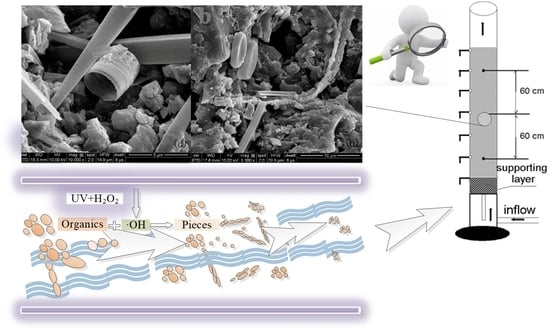Research about Organic Matter Removal and Biofilms Development of Pilot-Scale UV/H2O2-BAC Process
Abstract
:1. Introduction
2. Materials and Methods
2.1. Experimental Setup and Operating Conditions
2.2. Experimental Analysis Methods
2.2.1. Conventional Index
2.2.2. LC-OCD Scanning
2.2.3. High-Throughput Sequencing and Parameter Analysis
3. Results and Discussion
3.1. Organic Matter Removal by UV/H2O2-BAC Process
3.2. Organics Transform Analysis of UV/H2O2-BAC Process
3.2.1. Change of Molecular Weights of Organic Matters
3.2.2. LC-OCD-OND Fractionation Analysis
3.3. Analysis of Biofilms in Activated Carbons
3.3.1. Changes of Biomass Concentration and Inner DOC Removal Rate of Activated Carbon
3.3.2. Microbial Richness and Diversity
3.3.3. Comparison of Biological Community Structures
4. Conclusions
Supplementary Materials
Author Contributions
Funding
Institutional Review Board Statement
Informed Consent Statement
Data Availability Statement
Acknowledgments
Conflicts of Interest
References
- Feng, M.J.; Zhang, Q.; Song, N.H. Occurrence Characteristics and Risk Assessment of Antibiotics in Source Water of the Nanjing Reach of the Yangtze River. Environ. Sci. 2019, 40, 5286–5293. [Google Scholar]
- Zhang, Y.; Wang, J.; Lu, J.; Wu, J. Antibiotic resistance genes might serve as new indicators for wastewater contamination of coastal waters: Spatial distribution and source apportionment of antibiotic resistance genes in a coastal bay. Ecol. Indic. 2020, 114, 106299. [Google Scholar] [CrossRef]
- He, Q.; Weng, H. Removal Effect of Taste and Odor for Chemical Preoxidation of Sunvim Water Plant in Gaomi. Environ. Sci. Technol. 2016, 36, 247–250. [Google Scholar]
- Jia, R.B. Researches on algae change characteristics and influence factors in Yinhuang Reservoir. Ecol. Sci. 2013, 32, 757–762. [Google Scholar]
- Han, L.; Liu, W.; Chen, M.; Zhang, M.; Fei, X. Comparison of NOM removal and microbial properties in up-flow/down-flow BAC filter. Water Res. 2013, 47, 4861–4868. [Google Scholar] [CrossRef] [PubMed]
- Liu, C.; Olivares, C.I.; Pinto, A.J.; Lauderdale, C.V.; Brown, J.; Selbes, M.; Karanfil, T. The control of disinfection byproducts and their precursors in biologically active filtration processes. Water Res. 2017, 124, 630–653. [Google Scholar] [CrossRef]
- Zhu, H.; Jia, R.; Sun, S.; Feng, G.; Wang, M.; Zhao, Q.; Xin, X.; Zhou, A. Elimination of trichloroanisoles by UV/H2O2: Kinetics, degradation mechanism, water matrix effects and toxicity assessment. Chemosphere 2019, 230, 258–267. [Google Scholar] [CrossRef] [PubMed]
- Du, Z.; Jia, R.; Li, C.; Cui, P.; Song, W.; Liu, J. Pilot-scale UV/H2O2-BAC process for drinking water treatment—Analysis and comparison of different activated carbon columns. Chem. Eng. J. 2020, 382, 123044. [Google Scholar] [CrossRef]
- Sun, Y.; Angelotti, B.; Brooks, M.; Dowbiggin, B.; Evans, P.J.; Devins, B.; Wang, Z.-W. A pilot-scale investigation of disinfection by-product precursors and trace organic removal mechanisms in ozone-biologically activated carbon treatment for potable reuse. Chemosphere 2018, 210, 539–549. [Google Scholar] [CrossRef]
- Kim, W.H.; Nishijima, W.; Baes, A.U.; Okada, M. Micropollutant removal with saturated biological activated carbon (BAC) in ozonation-BAC process. Water Sci. Technol. 1997, 36, 283–298. [Google Scholar]
- Weber, W.J., Jr. Preloading of GAC by natural organic matter in potable water treatment systems: Mechanisms, effects and design considerations. J. Water Supply Res. Technol. AQUA 2004, 53, 469–482. [Google Scholar] [CrossRef]
- Liao, X.; Chen, C.; Wang, Z.; Wan, R.; Chang, C.; Zhang, X.; Xie, S. Pyrosequencing analysis of bacterial communities in drinking water biofilters receiving influents of different types. Process Biochem. 2013, 48, 703–707. [Google Scholar] [CrossRef]
- Lohwacharin, J.; Phetrak, A.; Takizawa, S.; Kanisawa, Y.; Okabe, S. Bacterial growth during the start-up period of pilot-scale biological activated carbon filters: Effects of residual ozone and chlorine and backwash intervals. Process Biochem. 2015, 50, 1640–1647. [Google Scholar] [CrossRef]
- Lautenschlager, K.; Hwang, C.; Ling, F.; Liu, W.T.; Boon, N.; Koester, O.; Egli, T.; Hammes, F. Abundance and composition of indigenous bacterial communities in a multi-step biofiltration-based drinking water treatment plant. Water Res. 2014, 62, 40–52. [Google Scholar] [CrossRef] [PubMed]
- Lautenschlager, K.; Hwang, C.; Liu, W.T.; Boon, N.; Koester, O.; Vrouwenvelder, H.; Egli, T.; Hammes, F. A microbiology-based multi-parametric approach towards assessing biological stability in drinking water distribution networks. Water Res. 2013, 47, 3015–3025. [Google Scholar] [CrossRef] [Green Version]
- Oh, S.; Hammes, F.; Liu, W.-T. Metagenomic characterization of biofilter microbial communities in a full-scale drinking water treatment plant. Water Res. 2018, 128, 278–285. [Google Scholar] [CrossRef] [PubMed]
- Congcong, L. Study on Biofilm Characteristics of Biological Activated Carbon Filtration Process; Shandong Jianzhu University: Jinan, China, 2018. [Google Scholar]
- Barai, A.; Guo, Y.; Mcgordon, A.; Jennings, P.A. Characterisation of aquatic humic and non-humic matter with size-exclusion chromatography-organic carbon detection-organic nitrogen detection (LC-OCD-OND). Water Res. 2011, 45, 879–885. [Google Scholar]
- Li, X.; Rao, N.R.H.; Linge, K.L.; Joll, C.A.; Khan, S.; Henderson, R.K. An evaluation of measurement techniques for algal-derived organic nitrogen. Water Res. 2019, 165, 114998. [Google Scholar] [CrossRef]
- Zhang, M.; Liu, W.; Nie, X.; Li, C.; Gu, J.; Zhang, C. Molecular analysis of bacterial communities in biofilms of a drinking water clearwell. Microbes Environ. 2012, 27, 443–448. [Google Scholar] [CrossRef] [Green Version]
- Afzal, A.; Oppenländer, T.; Bolton, J.R.; El-Din, M.G. Anatoxin-a degradation by Advanced Oxidation Processes: Vacuum-UV at 172 nm, photolysis using medium pressure UV and UV/H2O2. Water Res. 2010, 44, 278–286. [Google Scholar] [CrossRef] [PubMed]
- Rauf, M.A. Determination of opti-Muruganandhamm operating conditions of carmine decoloration by UV/H2O2 using response surfacemethodology. J. Hazard. Mater. 2009, 161, 281–286. [Google Scholar]
- Stefan, M.I. Advanced Oxidation Processes for Water Treatment-Fundamentals and Applications; IWA Publishing: London, UK, 2018. [Google Scholar]
- Ross, P.S.; van der Aa, L.T.J.; van Dijk, T.; Rietveld, L.C. Effects of water quality changes on performance of biological activated carbon (BAC) filtration. Sep. Purif. Technol. 2019, 212, 676–683. [Google Scholar] [CrossRef] [Green Version]
- Han, L. The Characteristics and Application of Micro-Expansion Up-Flow Biological Activated Carbon Process; Tinghua University: Beijing, China, 2013. [Google Scholar]
- Liang, C.H.; Chiang, P.C. Mathematical model of the non-steady-state adsorption and biodegradation capacities of BAC filters. J. Hazard. Mater. 2007, 139, 316–322. [Google Scholar] [CrossRef] [PubMed]
- Mahvi, A.H. Application of response surface methodology for optimization of natural organic matter degradation by UV/H2O2 advanced oxidation process. J. Environ. Health Sci. Eng. 2014, 12, 67. [Google Scholar]
- Chu, W.; Gao, N.; Yin, D.; Krasner, S.W.; Mitch, W.A. Impact of UV/H2O2 Pre-Oxidation on the Formation of Haloacetamides and Other Nitrogenous Disinfection Byproducts during Chlorination. Environ. Sci. Technol. 2014, 48, 12190–12198. [Google Scholar] [PubMed]
- Ding, S.; Wang, F.; Chu, W.; Chao, F. Using UV/H2O2 pre-oxidation combined with an optimised disinfection scenario to control CX3R-type disinfection by-product formation. Water Res. 2019, 167, 115096. [Google Scholar] [CrossRef]
- Marais, S.S.; Ncube, E.J.; Msagati, T.A.M.; Mamba, B.B.; Nkambule, T.T.I. Assessment of trihalomethane (THM) precursors using specific ultraviolet absorbance (SUVA) and molecular size distribution (MSD). J. Water Process Eng. 2019, 27, 143–151. [Google Scholar]
- Ates, N.; Kitis, M.; Yetis, U. Formation of chlorination by-products in waters with low SUVA-correlations with SUVA and differential UV spectroscopy. Water Res. 2007, 41, 4139–4148. [Google Scholar] [CrossRef]
- Zheng, J.; Lin, T.; Chen, W.; Tao, H.; Tan, Y.; Ma, B. Removal of precursors of typical nitrogenous disinfection byproducts in ozonation integrated with biological activated carbon (O3/BAC). Chemosphere 2018, 209, 68–77. [Google Scholar] [CrossRef]
- Conte, P.; Piccolo, A. Conformational arrangement of dissolved humic substances. Influence of solution composition on association of humic molecules. Environ. Sci. Technol. 1999, 33, 1682. [Google Scholar] [CrossRef]
- Gibert, O.; Lefevre, B.; Fernandez, M.; Bernat, X.; Paraira, M.; Calderer, M.; Martinez-Llado, X. Characterising biofilm development on granular activated carbon used for drinking water production. Water Res. 2013, 47, 1101–1110. [Google Scholar] [CrossRef] [PubMed]
- Moll, D.M.; Summers, R.S.; Fonseca, A.C.; Matheis, W. Impact of Temperature on Drinking Water Biofilter Performance and Microbial Community Structure. Environ. Sci. Technol. 1999, 33, 2377–2382. [Google Scholar] [CrossRef]
- Silvana, V.; Markus, B.; Oliver, K.; Jakob, H.; Hans-Ulrich, W.; Frederik, H. Development of biomass in a drinking water granular active carbon (GAC) filter. Water Res. 2011, 45, 6347–6354. [Google Scholar]
- Wang, F.; Halem, D.V.; Liu, G.; Lekkerkerker-Teunissen, K.; van der Hoek, J.P. Effect of residual H2O2 from advanced oxidation processes on subsequent biological water treatment: A laboratory batch study. Chemosphere 2017, 185, 637. [Google Scholar] [CrossRef] [PubMed]
- Wang, Y.; Du, Z.; Liu, Y.; Wang, H.; Xu, F.; Liu, B.; Zheng, Z. The nitrogen removal and sludge reduction performance of a multi-stage anoxic/oxic (A/O) biofilm reactor. Water Environ. Res. 2019, 92, 94–105. [Google Scholar] [CrossRef]
- Gerrity, D.; Arnold, M.; Dickenson, E.; Moser, D.; Sackett, J.D.; Wert, E.C. Microbial community characterization of ozone-biofiltration systems in drinking water and potable reuse applications. Water Res. 2018, 135, 207–219. [Google Scholar] [CrossRef] [PubMed]
- Zhang, Y.; Cong, J.; Lu, H.; Li, G.; Qu, Y.; Su, X.; Zhou, J.; Li, D. Community structure and elevational diversity patterns of soil Acidobacteria. J. Environ. Sci. 2014, 26, 1717–1724. [Google Scholar] [CrossRef]
- Wang, Y.; Liu, B.; Zhang, K.; Liu, Y.; Xu, X.; Jia, J. Investigate of in situ sludge reduction in sequencing batch biofilm reactor: Performances, mechanisms and comparison of different carriers. Front. Environ. Sci. Eng. 2018, 12, 1–15. [Google Scholar] [CrossRef]
- Zhu, S.; Wu, H.; Wu, C.; Qiu, G.; Feng, C.; Wei, C. Structure and function of microbial community involved in a novel full-scale prefix oxic coking wastewater treatment O/H/O system. Water Res. 2019, 164, 114961–114963. [Google Scholar] [CrossRef]
- Yang, H.; Yang, X.; Zhang, G.; Wang, B. Key Bacteria for the Microbial Degradation of Pollutants in Cellar Water. Environ. Sci. 2018, 39, 4766–4777. [Google Scholar]
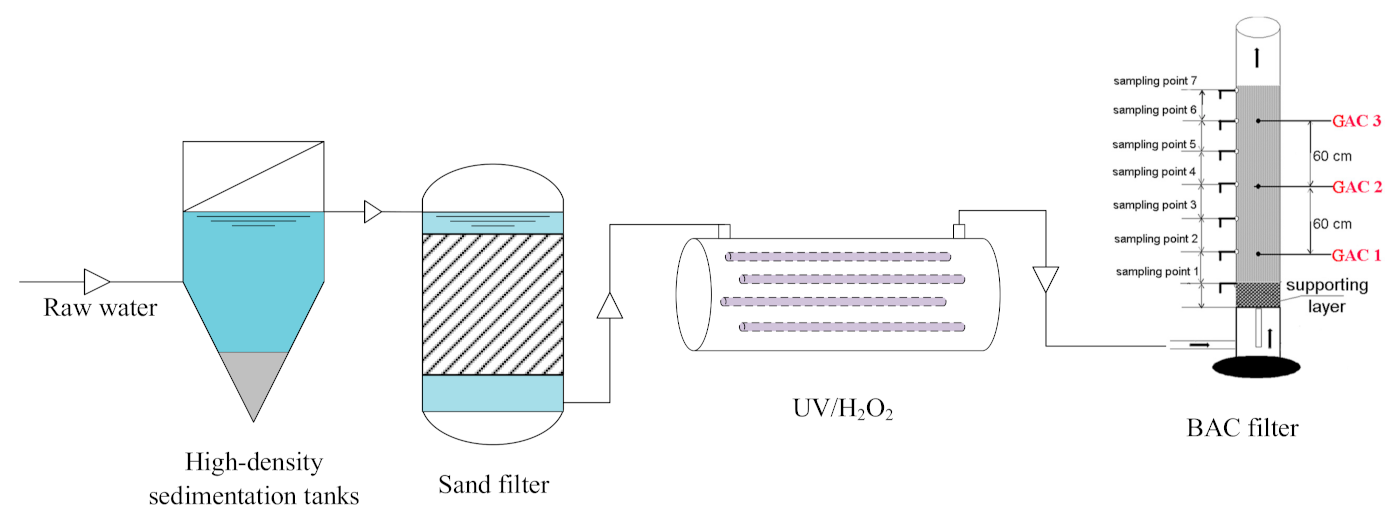
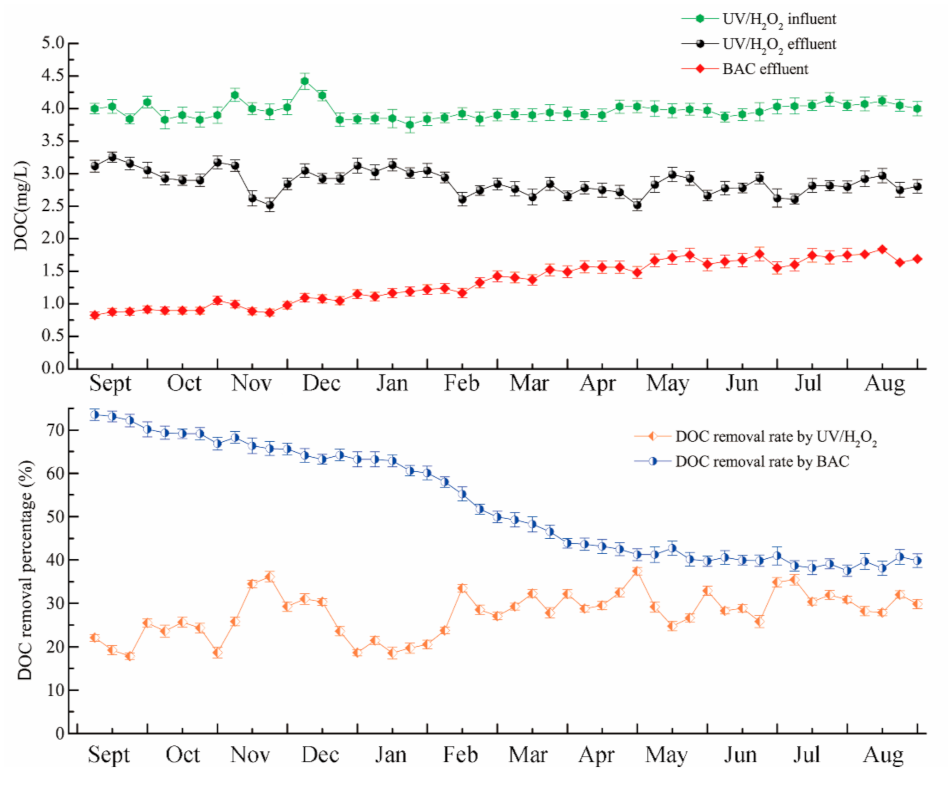

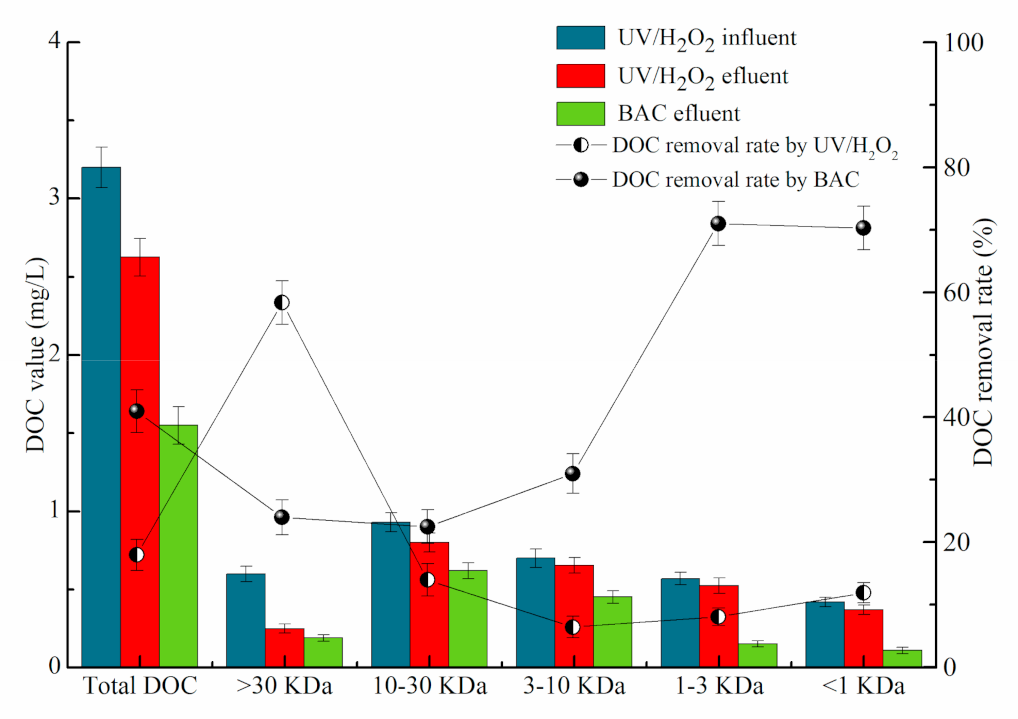
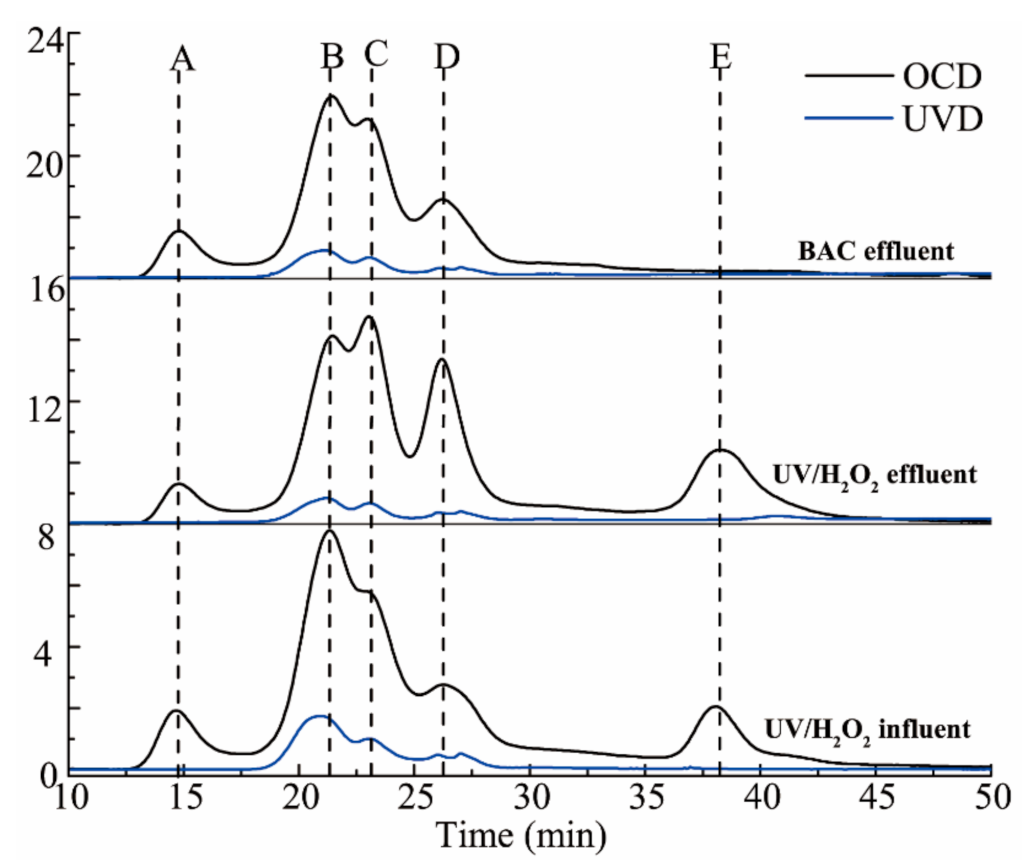
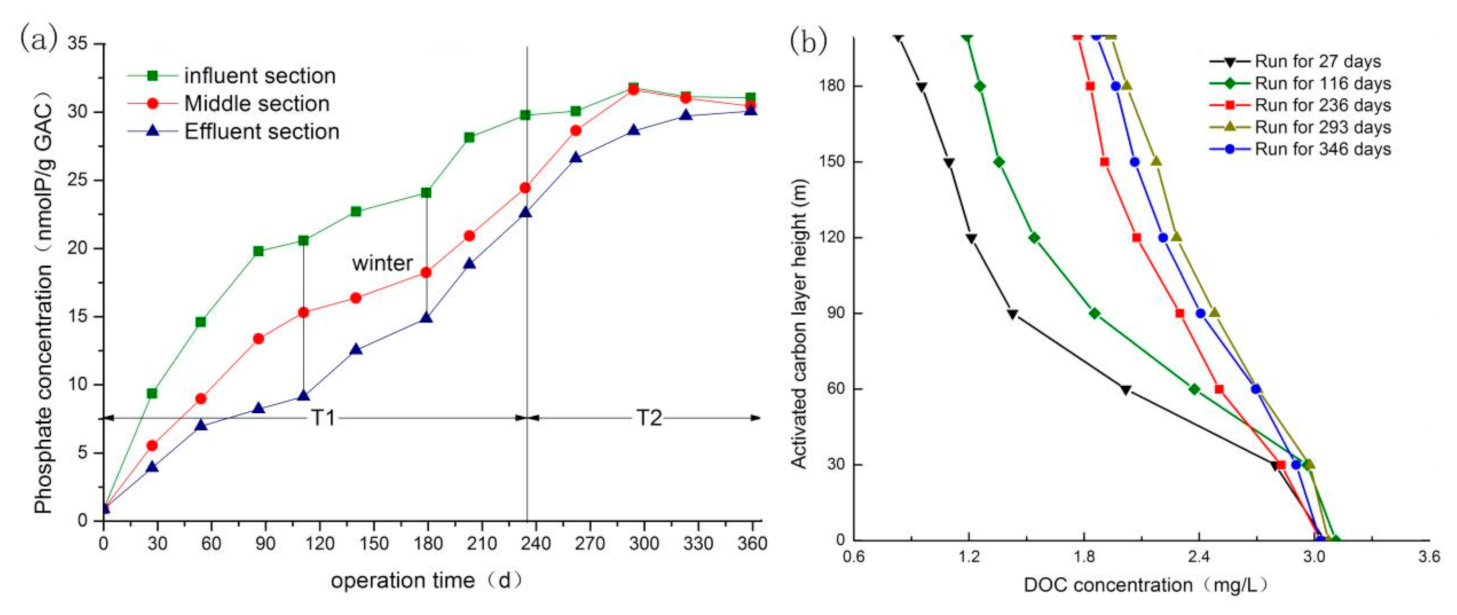
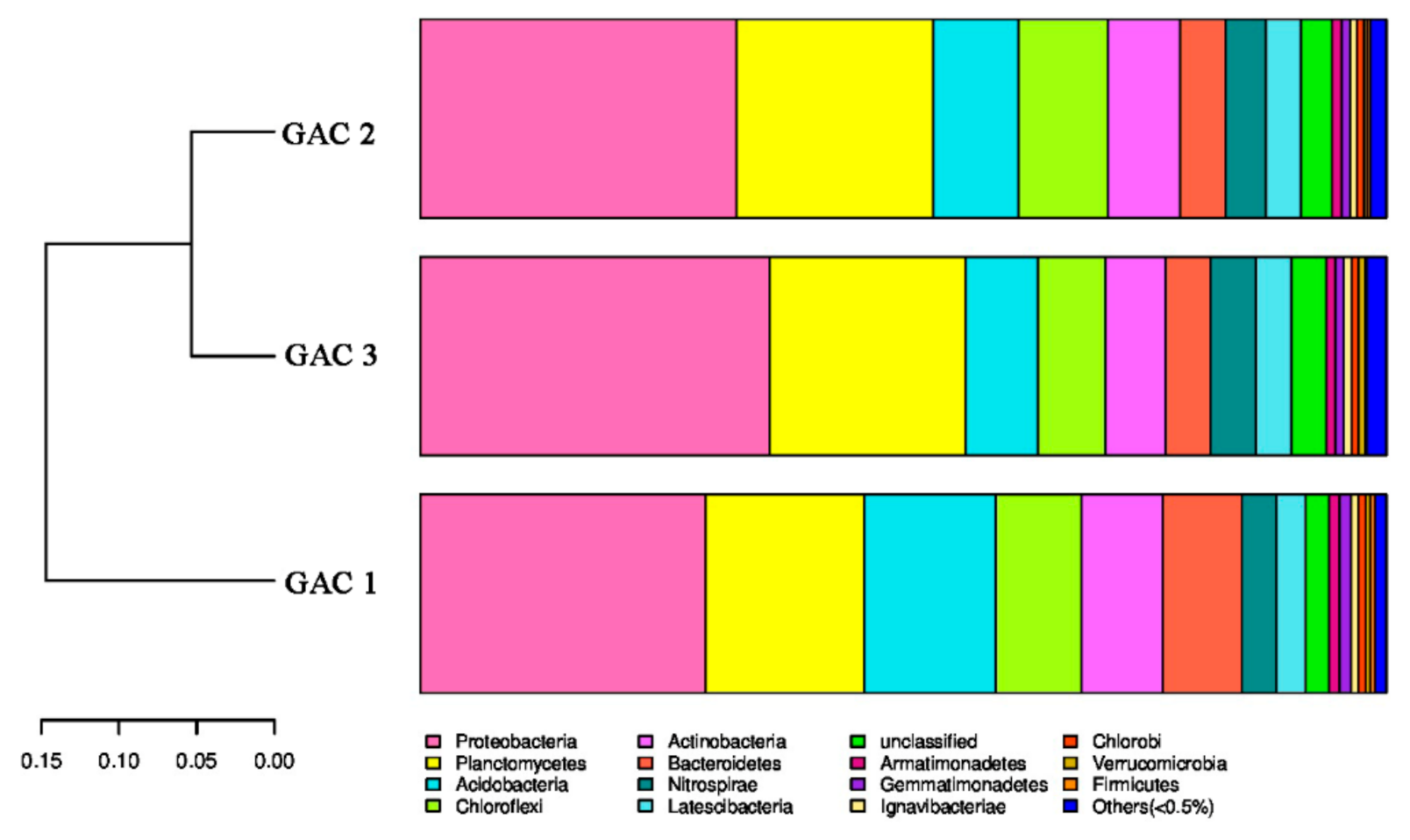

| Temp (°C) | Turbidity (NTU) | pH | UV254 (cm−1) | DOC (mg/L) | NH4+-N (mg/L) | H2O2 (mg/L) | DO (mg/L) | Br− (ug/L) | I− (ug/L) |
|---|---|---|---|---|---|---|---|---|---|
| 10–22 | 0.80–2.15 | 8.0–8.3 | 0.21–0.28 | 2.69–3.35 | 0.41–0.53 | 5–6.5 | 4.0–5.0 | 243–262 | 14–17 |
| Number | Detection Index | Determination Method |
|---|---|---|
| 1 | DOC | Shimazu TOC analyzer |
| 2 | DO | Thermo Orion 3star DO analyzer |
| 3 | UV254 | Ultraviolet spectrophotometry |
| 4 | H2O2 content | Spectrophotometry |
| 5 | SBET | AUTOSORB 6b analyzer |
| 6 | Molecular weight distribution | Ultrafiltration-TOC analyzer |
| 7 | Phospholipid biomass | Phosphatide method [17] |
| Humic | SUVA254 (L/mg·m) | SOM(mg/L) | Biopolymers | ||
|---|---|---|---|---|---|
| DON(mg/L) | Mol.-Weight(Mn) | % | |||
| UV/H2O2 influent | 0.1 | 445 | 2.19 | 0.328 | 100% |
| UV/H2O2 effluent | 0.069 | 355 | 1.02 | 0.259 | 90% |
| BAC effluent | 0.072 | 403 | 1.53 | <1 | 100% |
| Biopolymers | Humic | Building Blocks | LMW-Acids | LMW-Neutrals | |
|---|---|---|---|---|---|
| UV/H2O2 influent | 0.59 (16) | 1.82 (50) | 0.51 (14) | 0 (0) | 0.75 (20) |
| UV/H2O2 effluent | 0.39 (11.5) | 1.56 (46.2) | 0.53 (15.7) | 0.03 (1) | 0.87 (25.7) |
| BAC effluent | 0.31 (17) | 1.32 (54) | 0.40 (15) | 0 (0) | 0.38 (14) |
| Sample | OTUs | Chao 1 | ACE | Shannon | Simpson | Coverage |
|---|---|---|---|---|---|---|
| GAC 3 | 1181 | 1594 | 1265.32 | 5.79 | 0.77 | 99.1% |
| GAC 2 | 1215 | 1612 | 1295.44 | 5.80 | 0.73 | 99.2% |
| GAC 1 | 1160 | 1570 | 1210.12 | 5.90 | 0.61 | 99.3% |
| O3-BAC-1 | 291 | - | - | 4.39 | 0.757 | - |
| O3-BAC-2 | 282 | - | - | 4.57 | 0.821 | - |
Publisher’s Note: MDPI stays neutral with regard to jurisdictional claims in published maps and institutional affiliations. |
© 2021 by the authors. Licensee MDPI, Basel, Switzerland. This article is an open access article distributed under the terms and conditions of the Creative Commons Attribution (CC BY) license (http://creativecommons.org/licenses/by/4.0/).
Share and Cite
Song, W.; Li, C.; Du, Z.; Yue, J.; Sun, W.; Hou, L.; Liu, J.; Jia, R. Research about Organic Matter Removal and Biofilms Development of Pilot-Scale UV/H2O2-BAC Process. Water 2021, 13, 565. https://doi.org/10.3390/w13040565
Song W, Li C, Du Z, Yue J, Sun W, Hou L, Liu J, Jia R. Research about Organic Matter Removal and Biofilms Development of Pilot-Scale UV/H2O2-BAC Process. Water. 2021; 13(4):565. https://doi.org/10.3390/w13040565
Chicago/Turabian StyleSong, Wuchang, Congcong Li, Zhenqi Du, Jiangang Yue, Wenjun Sun, Lian Hou, Jianguang Liu, and Ruibao Jia. 2021. "Research about Organic Matter Removal and Biofilms Development of Pilot-Scale UV/H2O2-BAC Process" Water 13, no. 4: 565. https://doi.org/10.3390/w13040565






